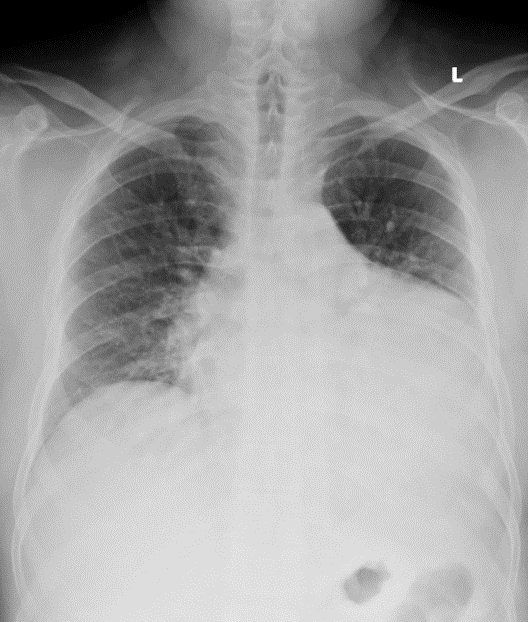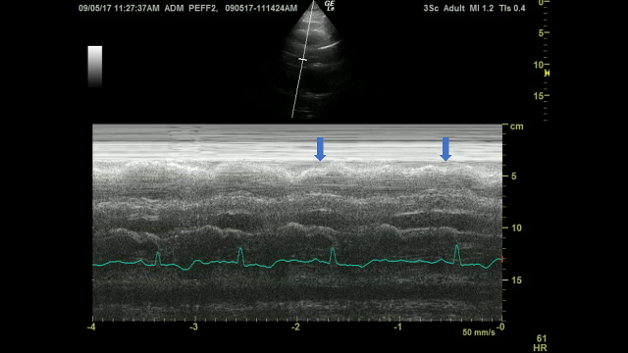Cardiac Tamponade
Presentation Date
09-20-17
Presenter
Dr. Javid Alakbari, PGY2
Expert Consultant(s)
- Dr. Joseph Krepp (Cardiology)
- Dr. Kemi Babagbemi (Radiology)
- Dr. Sophia Lin (ER)
History
49 y.o. man p/w progressive DOE, weakness, LE edema, exertional chest pain x 3 weeks +20 lbs weight gain.
PMHx:
- MI years ago(?)
- CVA
- HTN
- hypothyroidism
Meds: (Not Compliant)
- Levothyroxine 150mcg
- Amlodipine 10 mg
- Lisinopril/HCTZ 20/25mg
- Aspirin 81
Physical Exam:
- Obese man, laying flat on stretcher. NAD
- VS: 60, 120/80, 18, 92% on 2L NC
- Bibasilar Crackles otherwise clear lungs
- 2+ LEE up to knees
- JVD difficult to appreciate given body habitus
- no m/r/g on cardiac auscultation.
- Pulsus @ 25mmHg
Labs:
- CBC/BMP/LFT WNL
- trop: 0.21 → 0.19
- BNP: 14
- TSH: 34
CXR


Pulmonary venous congestion and cardiomegaly are evident. PA suggest a possibility of a left pleural effusion, which is not seen on the Lateral radiograph. Suggestion of LA enlargement (carina is splayed, LA protrudes posterially on the lateral view).
EKG

Low voltage in precordial leads. Though suggested, this is not true pulses alternans, which would typically alternate voltage with every other beat.
Point of Care Ultrasound
Pleural Space
Left Posterior Axilary Line
Normal Curtain Sign. No Pleural Effusion.
Parasternal Long-axis view
Large (>2 cm), mostly posteriorly located, simple pericardial effusion
Concern for Diastolic collapse of RVOT.
M-Mode in PLAx view
Blue arrows point towards diastolic collapse of the free wall of RVOT.
Normally, after systole an unimpeded movement away from the septum should be observed.

Apical 4-chamber view
Likely somewhat over-rotated. as a result RV may appear smaller than it actually is.
Large pericardial effusion.
Systolic RA collapse
RV free wall is not well seen, but there appears to be a diastolic collapse.
LV systolic Fx appears preserved, though enodcardial definition at the base is poor.
RV systolic fx is normal.
LA is enlarged
Subxiphoid long-axis view
Large pericardial effusion.
Effusion is mostly superior (anti-gravity), suggesting loculation.
A systolic collapse of RA and diastolic collapse of RV are now definitively seen.
For an “eyeball”, a sine wave going through the RV free wall usually indicates RV diastolic collapse.
Subxiphoid IVC Long-axis view
Note that IVC is moving in- and out of the plane of view with respirations, creating a false impression of “respiratory variability”.
Normally, with breathing IVC moves in coronal plane (left-to-right) and also up and down. This sometimes makes assessment of respiratory variability challenging. ref.
Still frame of IVC in the same view as above.
Note that each hatch mark on the scale on the left is 2 cm, and IVC is therefore > 2cm.
This is one of the areas of POCUS where “eyeballing” of structures should be discouraged. Because there are no reliable structures in the same field of view, such estimate may be grossly off.
This IVC was plethoric, i.e. dilated and not changing with respirations.

Mitral Inflow Velocity
by pulse-wave Doppler.
Note that sweep speed (a conceptual equivalent of paper speed on EKG machine) is set low. This allows for more cardiac cycles to be displayed on one screen.
A significant (>30%) variability in the height of the E wave (LV inflow velocity during rapid filling). This is a positive Doppler sign of cardiac tamponade and is an echo equivalent of Pulsus Paradoxus.

Subsequent Hospital Course and Follow Up
- Given 500cc Bolus of NS
- Cardiology consulted STAT. TTE performed confirming Large effusion
- Pericardiocentesis performed w/removal of 1L of fluid
- Fluid c/w exudate
- Protein 6.6 – Serum Protein 7.7
- LDH 681 – serum LDH 782
- Labs:
- Quantiferon gold (-)
- ANA (-)
- ESR: 30, CRP < 0.4
- Presumed cause of effusion; 2/2 Hypothyroidism
- Multiple serial post-procedure TTEs showed persistent but asymmetric and stable effusion.
- Remained HD stable. Discharged home with f/u
Papers Presented
- Merce et al., Am Heart J. 1999 Oct;138(4 Pt 1):759-64.
Correlation between clinical and Doppler echocardiographic findings in patients with moderate and large pericardial effusion: implications for the diagnosis of cardiac tamponade. - Himelman et al., JACC 1988;12(6);1470-7.
Inferior Vena Cava Plethora With Blunted Respiratory Response: A Sensitive Echocardiographic Sign of Cardiac Tamponade.